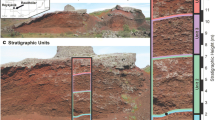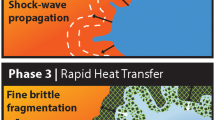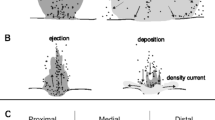Abstract
The effects of external water during hydrovolcanic eruptions are difficult to quantify; however, research investigating the explosive interactions between surface lava flows and water has provided new insights into explosion dynamics. Previous work has focused on relatively low-energy lava–water explosions from a 100-m-diameter cone in the Rauðhólar cone group in Iceland. For comparison, we study ejecta derived from higher-energy explosions at the 400-m-diameter Pu‘u Kīholo rootless cone in Hawai‘i, one of the largest rootless cones on Earth. This comparative approach elucidates the effect of lava–water mixing conditions and range of explosivity on ejecta characteristics. Utilizing grain size analysis, we found that Pu‘u Kīholo beds typically have median grain sizes at the cone rim that are smaller than − 3 ϕ (8 mm) and are on average finer-grained than those of the Rauðhólar cone. Ash-sized grains, the most energetically significant ejecta size fraction, typically make up > 20% of bed ejecta, with a maximum of 90%, both greater proportions than found in beds of the Rauðhólar cone. Utilizing grain morphology, crystal texture, and surface feature analysis, we found that the abundance of ash-sized grains associated with high heat transfer rates (i.e., active particles) increases at Pu‘u Kīholo as explosivity increases, which is an important consideration for energy modeling. This dataset also includes ejecta from the finest-grained beds, and therefore highest-energy lava–water explosions, studied to date.














Similar content being viewed by others
References
Blott SJ, Pye K (2001) GRADISTAT: a grain size distribution and statistics package for the analysis of unconsolidated sediments. Earth Surf Process Landf 26(11):1237–1248
Büttner R, Zimanowski B (1998) Physics of thermohydraulic explosions. Phys Rev E 57(5):5726–5729
Büttner R, Dellino P, Zimanowski B (1999) Identifying magma–water interaction from the surface features of ash particles. Nature 401(6754):688–690
Büttner R, Dellino P, La Volpe L, Lorenz V, Zimanowski B (2002) Thermohydraulic explosions in phreatomagmatic eruptions as evidenced by the comparison between pyroclasts and products from molten fuel coolant interaction experiments. Journal of Geophysical Research: Solid Earth 107(B11):5–14
Colgate SA, Sigugeirsson T (1973) Dynamic mixing of water and lava. Nature 244(5418):552–555
Dürig T, Zimanowski B (2012) “Breaking news” on the formation of volcanic ash: fracture dynamics in silicate glass. Earth Planet Sci Lett 335:1–8
Dürig T, Sonder I, Zimanowski B, Beyrichen H, Büttner R (2012) Generation of volcanic ash by basaltic volcanism. J Geophys Res: Solid Earth 117(B1). https://doi.org/10.1029/2011JB008628
Fagents SA, Thordarson T (2007) Rootless volcanic cones in Iceland and on Mars. In: Chapman MG (ed) The geology of Mars: evidence from earth-based analog. Cambridge University Press, United Kingdom, pp 151–177
Fisher RV (1968) Pu‘u Hou littoral cones, Hawaii. Geol Rundsch 57(3):837–864
Fitch EP, Fagents SA, Thordarson T, Hamilton CW (2017) Fragmentation mechanisms associated with explosive lava–water interactions in a lacustrine environment. Bull Volcanol 79(1). https://doi.org/10.1007/s00445-016-1087-3
Folk RL, Ward WC (1957) Brazos River bar: a study in the significance of grain size parameters. J Sediment Petrol 27:3–26
Greeley R, Fagents SA (2001) Icelandic pseudocraters as analogs to some volcanic cones on Mars. Journal of Geophysical Research: Planets 106(E9):20527–20546
Grunewald U, Zimanowski B, Büttner R, Phillips LF, Heide K, Büchel G (2007) MFCI experiments on the influence of NaCl-saturated water on phreatomagmatic explosions. J Volcanol Geotherm Res 159(1–3):126–137
Hamilton CW, Fitch EP, Fagents SA, Thordarson T (2017) Rootless tephra stratigraphy and emplacement processes. Bull Volcanol 79(1). https://doi.org/10.1007/s00445-016-1086-4
Harris AJ, Rowland SK (2015) Lava flows and rheology. In: Sigurdsson H, Houghton B, McNutt S, Rymer H, Stix J (eds) The Encyclopedia of Volcanoes. Academic Press, pp 321–342
Heiken G, Wohletz K (1985) Volcanic ash. University Press, California, Chicago, Harvard & MIT
Horwell CJ (2007) Grain-size analysis of volcanic ash for the rapid assessment of respiratory health hazard. J Environ Monit 9(10):1107–1115
Houghton B, Hackett W (1984) Strombolian and phreatomagmatic deposits of Ohakune Craters, Ruapehu, New Zealand: a complex interaction between external water and rising basaltic magma. J Volcanol Geotherm Res 21(3):207–231
Houghton B, Schmincke H (1986) Mixed deposits of simultaneous strombolian and phreatomagmatic volcanism: Rothenberg volcano, East Eifel volcanic field. J Volcanol Geotherm Res 30(1):117–130
Houghton BF, Wilson CJN (1989) A vesicularity index for pyroclastic deposits. Bull Volcanol 51(6):451–462
Jurado-Chichay Z, Rowland SK, Walker GP (1996) The formation of circular littoral cones from tube-fed pāhoehoe: Mauna Loa, Hawai‘i. Bull Volcanol 57(7):471–482
Kauahikaua J, Cashman KV, Mattox TN, Heliker CC, Hon KA, Mangan MT, Thornber CR (1998) Observations on basaltic lava streams in tubes from Kilauea Volcano, island of Hawai‘i. Journal of Geophysical Research: Solid Earth 103(B11):27303–27323
Lorenz V (1987) Phreatomagmatism and its relevance. Chem Geol 62(1–2):149–156
Manga M, Patel A, Dufek J (2011) Rounding of pumice clasts during transport: field measurements and laboratory studies. Bull Volcanol 73(3):321–333
Mastin LG (2007) Generation of fine hydromagmatic ash by growth and disintegration of glassy rinds. J Geophys Res: Solid Earth 112(B2): https://doi.org/10.1029/2005JB003883
Mattox TN, Mangan MT (1997) Littoral hydrovolcanic explosions: a case study of lava–seawater interaction at Kilauea volcano. J Volcanol Geotherm Res 75(1–2):1–17
Moore JG, Ault WU (1965) Historic littoral cones in Hawaii. Pac. Sci. XIX 1:3–11
Morrissey M, Zimanowski B, Wohletz K, Buettner R (2000) Phreatomagmatic fragmentation. In: Houghton B, Rymer H, Stix J, McNutt S (eds) Encyclopedia of volcanoes. Academic Press, San Diego, pp 431–445
Rowland SK, Walker GP (1987) Toothpaste lava: characteristics and origin of a lava structural type transitional between pāhoehoe and aa. Bull Volcanol 49(4):631–641
Sheridan MF, Wohletz KH (1983) Hydrovolcanism: basic considerations and review. J Volcanol Geotherm Res 17(1–4):1–29
Sonder I, Harp AG, Graettinger AH, Moitra P, Valentine GA, Büttner R, Zimanowski B (2018) Meter-scale experiments on magma–water interaction. Journal of Geophysical Research: Solid Earth 123(12):10–597
Trusdell FA, Lockwood JP (in press) Geologic map of the lower-southwest rift zone of Mauna Loa Volcano, Island of Hawai‘i, Hawaii: U.S. Geological Survey SIM 2932-C, scale 1:50,000
Von Komorowicz M (1912) Vulkanologische studien auf einigen inseln des Atlantischen Oceans. E. Schweizerbart, Stuttgart, Germany
Westervelt WD (1916) Hawaiian legends of volcanoes. Ellis Press
Wohletz KH (1983) Mechanisms of hydrovolcanic pyroclast formation: grain-size, scanning electron microscopy, and experimental studies. J Volcanol Geotherm Res 17(1–4):31–63
Wohletz KH (1986) Explosive magma–water interactions: thermodynamics, explosion mechanisms, and field studies. Bull Volcanol 48(5):245–264
Wohletz KH, McQueen R (1981). Experimental hydromagmatic volcanism. Amer. Geophys. Union Trans., EOS 62(45):1085
Wohletz KH, McQueen RG (1984) Experimental studies of hydromagmatic volcanism. In: Explosive volcanism: inception, evolution, and hazards. Studies in geophysics. National Academy Press, Washington, DC. pp 158–169
Wohletz KH, Zimanowski B, Büttner R (2013) Magma–water interactions. In: Fagents SA, Gregg TKP, Lopes RMC (eds) Modeling volcanic processes. Cambridge University Press, New York, pp 230–257
Xie S-P, Liu WT, Liu Q, Nonaka M (2001) Far-reaching effects of the Hawaiian Islands on the Pacific Ocean-atmosphere system. Science 292(5524):2057–2060
Zimanowski B (2001) Phreatomagmatic explosions. In: Freundt A, Rosi M (eds) From magma to tephra: modeling physical processes of explosive volcanic eruptions, developments in volcanology 4. Elsevier Science B.V, Amsterdam, The Netherlands, p 336
Zimanowski B, Büttner R, Lorenz V, Häfele H-G (1997a) Fragmentation of basaltic melt in the course of explosive volcanism. Journal of Geophysical Research: Solid Earth 102(B1):803–814
Zimanowski B, Büttner R, Lorenz V (1997b) Premixing of magma and water in MFCI experiments. Bull Volcanol 58(6):491–495
Zimanowski B, Wohletz K, Dellino P, Büttner R (2003) The volcanic ash problem. J Volcanol Geotherm Res 122(1):1–5
Zimanowski B, Büttner R, Dellino P, White JD, Wohletz KH (2015) Magma-water interaction and phreatomagmatic fragmentation. In: Houghton B, McNutt S, Rymer H, Stix J (eds) Sigurdsson H. Academic Press, The Encyclopedia of Volcanoes, pp 473–484
Acknowledgments
We would like to thank the Hawai‘i Department of Land and Natural Resources for the access to the study area, which required a permit. We are grateful to Gary Huss, Phillip Ooi, Elizabeth Koeman-Shields, and Jessica Galacgac for the instrumentation access and training. This work was improved by discussions with Frank Trusdell, Don Swanson, Bruce Houghton, Scott Rowland, and Carolyn Parcheta. We acknowledge journal reviews by Alison Graettinger, an anonymous reviewer, and associate editor Pierre-Simon Ross. Lastly, this work could not have been done without the field assistance and good company of Jenn Randell-Tamaariki and Bryant Quinonez-Servin.
Funding
This work was supported by the University of Hawai‘i Bullard Fellowship and HIGP (publication number 2416) and SOEST (publication number 11018).
Author information
Authors and Affiliations
Corresponding author
Additional information
Editorial responsibility: P-S. Ross
Rights and permissions
About this article
Cite this article
Fitch, E.P., Fagents, S.A. Characteristics of rootless cone tephra emplaced by high-energy lava–water explosions. Bull Volcanol 82, 62 (2020). https://doi.org/10.1007/s00445-020-01393-5
Received:
Accepted:
Published:
DOI: https://doi.org/10.1007/s00445-020-01393-5




